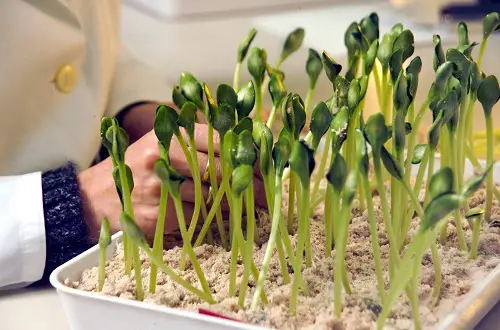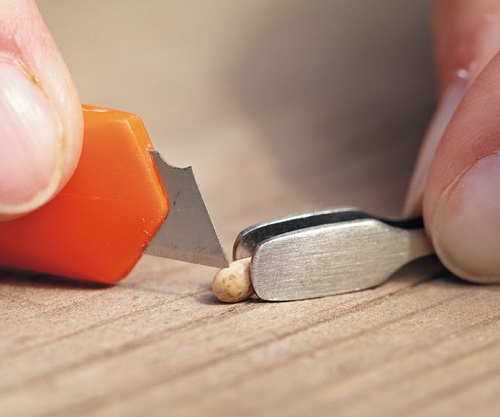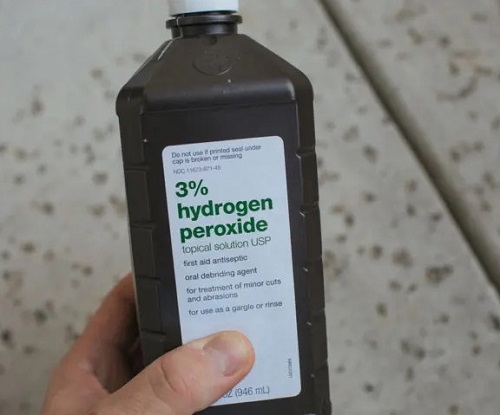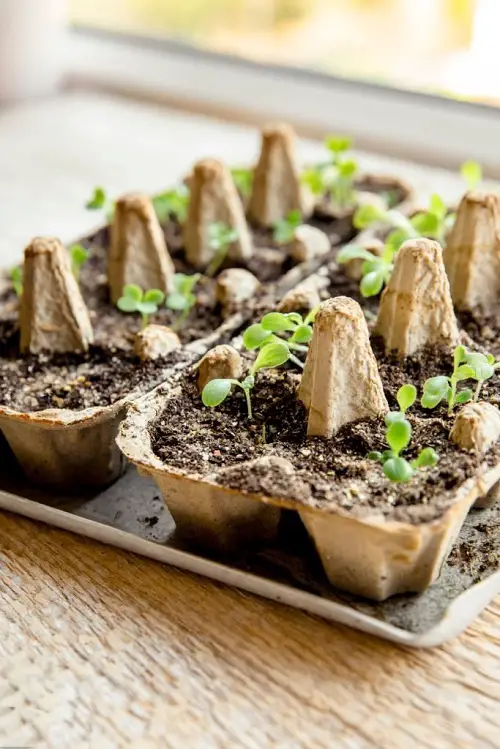Germinate Seeds Faster with these tricks and tips and ensure the seedlings stay safe and grow well.
Growing plants is an exciting and essential part of gardening, especially from seeds, but it can also be frustrating when they take a long time to sprout. Luckily, there are a few tricks that will help in Germinate Seeds Faster! Let’s have a look!
Use This Vodka Hack to Germinate Seeds & Propagate Cuttings Quickly
What is Seed Germination?
In gardening, the term germination refers to the process of seed coming out of its dormant state, sprouting, and developing into a plant. The term “seed starting” is often used interchangeably with germination.
Seed Germination Time
The time required for germination can differ significantly between plant species, with an average range of 2-4 weeks. Smaller seeds tend to absorb water faster, resulting in quicker germination. Conversely, larger seeds with thicker shells require more time to absorb the necessary water for germination.
Types of Seeds
1. Cool and Cold Crops
Generally speaking, spring and fall crops such as peas and salad greens thrive in colder temperatures and are also well-suited for seed sowing in moderate soil temperatures.
Typically, this group of crops has the best germination rates when the soil temperature is between 50-68° F (10-20° C), although there may be some exceptions.
2. Warm Crops
In general, crops such as tomatoes, eggplants, and peppers are sensitive to cold temperatures and require warmer soil to germinate. Typically, these crops prefer soil temperatures between 65-79° F ( 18-26° C), but there may be some exceptions.
Peppers and squashes, for instance, tend to be more receptive to slightly higher temperatures.
Tricks to Germinate Seeds Faster
1. Nick the Seeds
The tough outer coating of seeds acts as a protective layer that prevents damage or infection by pathogens. However, for germination to occur, water must penetrate this shell.
Scarification, a method of puncturing the seed’s outer shell, can expedite the germination process by allowing water to enter.
- For larger seeds, a small knife can be used to nick the shell, being careful not to damage the interior.
- For smaller seeds, placing them in a jar with sandpaper and shaking it gently will create tiny scratches on the shell, facilitating water absorption.
Scarification should be performed just before planting to Germinate Seeds Faster.
2. Pre-soak the Seeds
Soaking seeds before planting can help soften their hard outer coating and encourage faster germination.
To pre-soak seeds, simply place them in a bowl of lukewarm water for a few hours or overnight, depending on the seed type.
3. Make Your First Watering a Soapy One
Wet seed starting mix with mildly warm, soapy water before planting to break down waxy seed coats and prevent dry soil eruptions. Mist with soapy water again after planting. Add mix to pots, mist the top, then slowly drench with soapy water.
Plant seeds and cover with necessary dirt, then spray with soapy water. Using a spray bottle to water tiny seeds prevents unearthing and applies soap for scarification.
4. Use Hydrogen Peroxide Solution
Soaking seeds in water overnight is a common method for improving germination rates, but adding hydrogen peroxide (H2O2) can enhance this process even more.
By breaking down the seed coat and oxygenating the water, hydrogen peroxide speeds up germination by providing the seed with the oxygen it needs for energy. To use this method, click here, and you will see the step-by-step article.
Look at the Hydrogen Peroxide Uses in the Garden.
5. Germinate on Damp Paper Towels
To germinate seeds faster, you can use an airtight container, a damp paper towel, and your seeds. Dampen the paper towel and place it inside the container. Spread the seeds on top and close the lid.
Keep the container in a warm place, away from direct sunlight. Once the roots start emerging, transplant the seedlings into the soil.
Avoid letting the roots get too long before transferring them into the soil.
6. Place Seed Tray on a Heat Mat
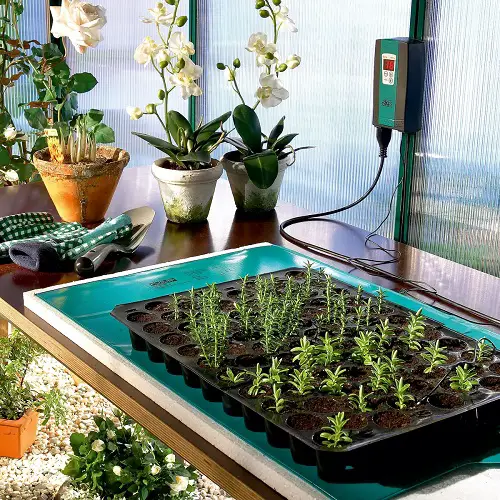
To facilitate germination, it is crucial to maintain the minimum temperature range of 50-60 F (10 to 15 C) at least. If you cannot achieve this soil temperature naturally, a heat mat can be a useful tool.
Heat mats are available in both electric and non-electric models, with the electric models providing more precise temperature control. Consider using a waterproof, double-insulated pad that is easy to operate.
7. Use Grow Lights for Extra Warmth
Using grow lights is an alternative approach to achieving the ideal germination temperature. Although most seeds do not require light to sprout, some bulbs emit heat that can warm the seed tray and facilitate germination. This technique can be particularly useful if you live in a cold region or are starting seeds in the winter season.
Some of the best types of grow lights to use for germinating seeds are LED grow lights, fluorescent grow lights, and high-pressure sodium (HPS) grow lights.
8. Cover the Seed Tray With a Humidity Dome
Maintaining adequate moisture is crucial for triggering seed germination, and a humidity dome can help retain moisture in the air and soil.
While any cover can increase humidity, it is recommended to use clear covers to enable the visibility of the seeds. It allows light to penetrate and aid in the growth of emerging seedlings.
Alternatively, you can use a plastic bag or plastic wrap to cover the top of your seed tray and create a makeshift humidity dome.
Read Try 7 Nail Clipper Hacks for Successful Germination
9. Plant Seeds in a Seed-Starting Mix
A seed-starting mix is a sterile, lightweight potting soil specifically designed for germinating seeds. It is usually made of peat moss, perlite, and vermiculite, which provide air circulation and moisture control.
The mix is designed to help retain moisture while also providing good drainage. This allows the seeds to expand without becoming waterlogged, which can cause them to rot or fail to germinate.
Additionally, the mix is free of weeds and diseases, so the seedlings have a better chance of establishing healthy root systems.
10. Germinate Seeds in an Instant Pot
The process involves using an Instant Pot, damp paper towels, and a plastic bag. First, put the seeds between damp paper towels and enclose them in a plastic bag. Subsequently, place the bag inside the Instant Pot and use the setting to maintain a constant low heat.
This method is particularly effective for warm-weather plants such as peppers, tomatoes, and watermelons.
11. Vodka Hack
To speed up seed germination, mix half a teaspoon of vodka into a gallon of water and soak the seeds in the solution for 20-30 minutes.
Afterward, rinse the seeds thoroughly with distilled or reverse osmosis water before planting to remove any residual alcohol. This method can significantly increase the germination rate of your seeds. Read more here.
12. Vinegar Hack
To prepare the seeds for planting, mix one teaspoon of vinegar with a cup of water in a bowl. Submerge the seeds in this solution for no longer than 12 hours, preferably overnight.
The next day, proceed with your usual planting method. If you’re looking for a faster germination process, you can also try the paper towel method. Read more here.
13. Smoke Treatment
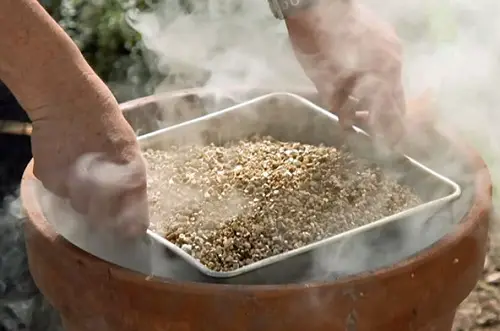
Smoke treatment for seed germination is a process by which seeds are exposed to smoke to increase the rate of germination. It is based on the idea that smoke contains compounds that can stimulate the germination process.
This process is most commonly used with seeds from fire-adapted species such as grasses and shrubs. Smoke treatment is thought to mimic the environment of a natural fire, which triggers the release of dormancy in many seeds.
The smoke is usually generated by burning wood, but some studies have used smoke from burning dried grasses, leaves, or other plant materials. The smoke may be introduced to the seeds in a variety of ways, including direct exposure to the smoke, soaking the seeds in a smoke solution, or using a smoke generator.
Studies have shown that smoke treatment can significantly increase the rate of germination in many species.
14. Biodegradable Pots
Biodegradable pots for seed germination are made from materials such as peat, newspaper, coconut coir, and wood fiber. These materials decompose in the soil, improving nutrient and water retention while providing a safe and sustainable environment for young seedlings.
They are also designed to be breathable, allowing the root system to access oxygen and moisture.
15. Use Seedling Transplanter
Seedling transplanters are tools designed to help gardeners, farmers, and other growers move seedlings from germination trays to individual pots or larger planting beds.
The transplanter has a plunger on one end that is inserted into the soil of a germination tray. When the plunger is pushed down, the seedling and some of the surrounding soil are lifted out of the tray.
The seedling is then placed in a pot or directly into the ground. Seedling transplanters can also be used to transplant larger plants or to thin out overcrowded plantings.


